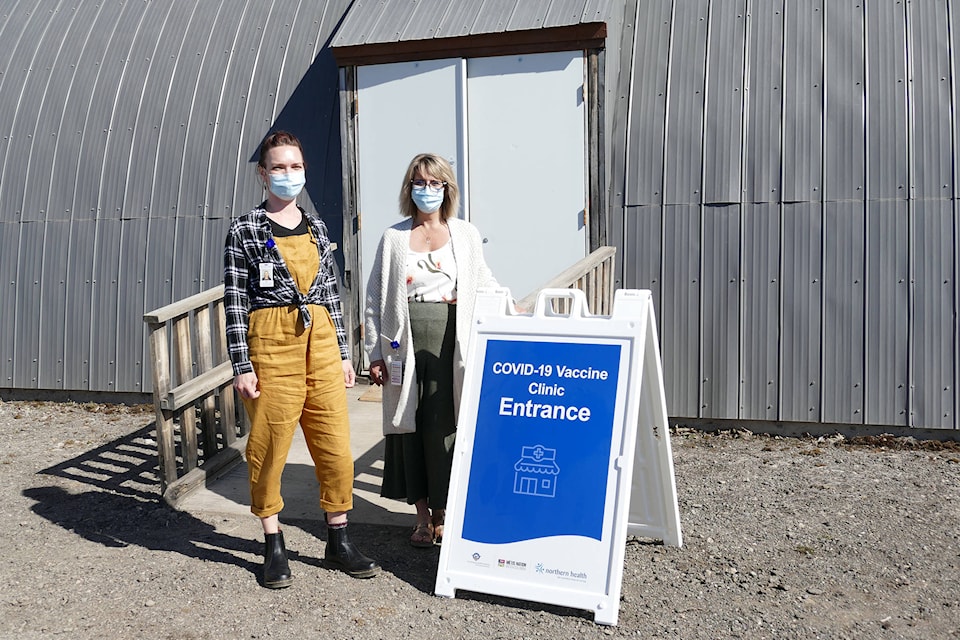With the first COVID-19 vaccination clinics wrapped up in Burns Lake, Granisle and Houston, numbers on vaccine-takers are coming in and aren’t close to the provincial expectations.
“The rates of eligible population immunized in the Burns Lake Local Health Area (which includes three community health service sub-areas) average approximately 50 per cent and for Burns Lake Centre, it’s 51.57 per cent,” said Eryn Collins from Northern Health.
The Burns Lake North Community Health Services Area that includes Granisle now has around 50 per cent residents who received at least one dose. That figure came at the conclusion of a period of community clinics in Burns Lake and the one-day clinic held on April 22.
The one-day clinic in Burns Lake was successful, with 77 people walking-in to get their first shots.
Burns Lake held vaccination clinics for all residents 18 and above at the Curling Club at Lakeside Multiplex in Burns Lake from Apr. 6 to Apr. 10 and from Apr. 12 to Apr. 16. During the first week, residents received the Pfizer vaccine while the second week residents received the Moderna vaccine.
Approximately 1800 residents were vaccinated during the two-week clinic in Burns Lake.
The percentage of eligible people in Granisle receiving a vaccination was not available but Northern Health said 203 appointments were completed at that community’s clinic.
“Those who did not book into the local [Granisle] clinic, will be able to do so in the Burns Lake clinic, going forward.
“While I’m unable to break that down any further into age groups or ethnicities – I can say that vaccine uptake is higher in older age groups and gradually declines, the younger the group; but that is consistent across the North, not unique to Houston or Burns Lake North,” she said.
Currently there are no plans to hold more clinics in Burns Lake however, Collins said that additional vaccination opportunities will be added.
Collins clarified that the low uptake for the vaccines was not due to inadequate vaccine supply or lack of appointments. In fact, she said that any unused vials of vaccines would be redistributed to other vaccination efforts in the province.
“We plan clinics based on population numbers of those eligible, and vaccine supply; clinics fill up at variable rates, and the local teams work hard to adjust clinics based on the needs and interest of the community residents. There was adequate vaccine supply and appointment availability,” she said.
Two weeks ago the provincial government began releasing the AstraZeneca vaccine through pharmacies for people between the age of 55 and 65, later dropping the age to 40. As of late last week there were 624 pharmacies offering AstraZeneca vaccine across the province. However that list did not include pharmacies in Houston, Burns Lake or Smithers and there is no indication yet of when these pharmacies might be supplied.
“The availability of the vaccine is continually changing and as we receive more supply, we’re able to add more pharmacies to our immunization program. We will continue to direct the vaccine where it is needed most,” indicated a statement from the health ministry.
Along Hwy16, the vaccine was available at 12 Prince George pharmacies and three in Terrace.
SFU report on herd immunity
Despite the ramped-up vaccination efforts in Northern B.C., province-wide, not enough British Columbians will be acquiring immunity by Fall as per two Simon Fraser University (SFU) professors.
Simulations run by mathematicians Paul Tupper and Caroline Colijn show that at the province’s current rate of inoculations, reopening in September would lead to “substantial rises in cases and hospitalizations.”
Nearly 470,000 people would be infected, approximately three times the number of B.C. infections to date.
The province is aiming to provide every eligible adult with a second COVID-19 vaccine dose by September under its current vaccination program. This means a large portion of the population, 49 per cent, will still be unprotected – nine percent short of the minimum 60 per cent needed in order for B.C. to achieve herd immunity.
This includes children, for whom COVID-19 vaccines are not yet approved, adults who refuse to get a shot and people for whom the vaccine isn’t effective.
However, since only 80 per cent of B.C.’s population is adult and only 80 per cent of those adults are expected to get vaccinated. The key, the professors said, could lie in vaccinating kids.
- with files from Rod Link and Sarah Grochowski
